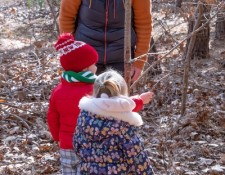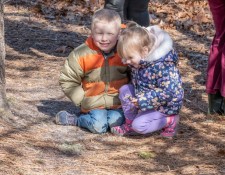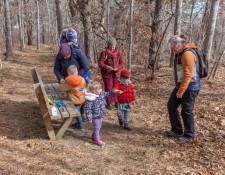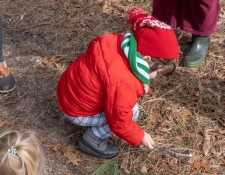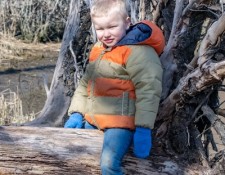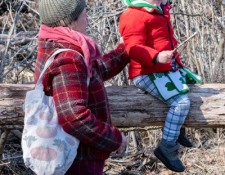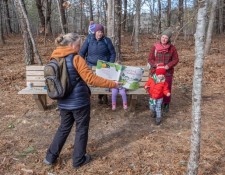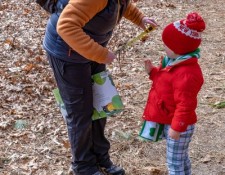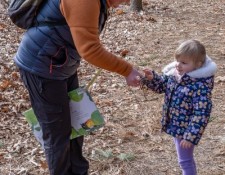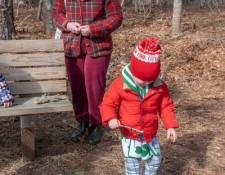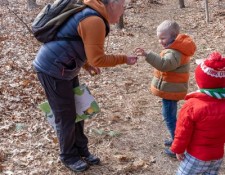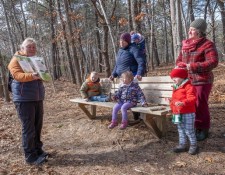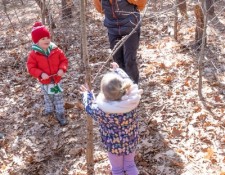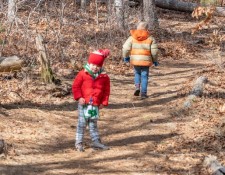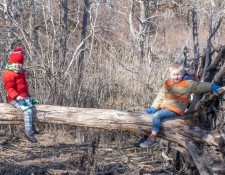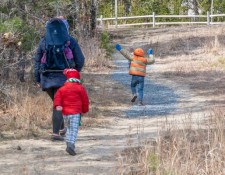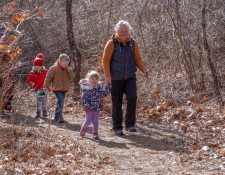Preschool Explorers Discover the Worm Moon, Insects, and Walking Sticks
Reflections by Naturalist & Walk Leader Andrea Higgins
Photos courtesy of HCT Volunteer Photographer Gerry Beetham
 The joyful singing and giggling of Harwich Conservation Trust’s Preschooler Explorers filled the beautiful 17-acre Muddy Creek Headwaters Preserve as we shared this brilliant blue-sky morning together.
The joyful singing and giggling of Harwich Conservation Trust’s Preschooler Explorers filled the beautiful 17-acre Muddy Creek Headwaters Preserve as we shared this brilliant blue-sky morning together.
We first chatted about today’s “Worm Moon” – the last full moon of winter. According to the Farmer’s Almanac, as the temperatures begin to warm and the ground thaws, earthworm casts appear, giving this month’s moon its name and heralding the return of the robins. Northern Native American tribes knew this moon as the Crow Moon, as it coincides with the cawing of crows as they signal the end of winter.
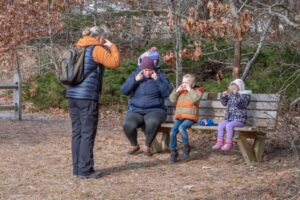 How exciting for our HCT Explorers to hear the “caw, caw, caw” of crows at the Preserve this morning celebrating spring’s return. Migrating birds are beginning to return as insects awaken and the days lengthen. We chatted about insects with their many legs and reviewed the names of their body parts. To the tune of “head, shoulders, knees, and toes,” we instead sang the parts of an insect: “head, thorax, abdomen (abdomen), mouth and eyes and antennae too, six legs and that’s an insect for you.”
How exciting for our HCT Explorers to hear the “caw, caw, caw” of crows at the Preserve this morning celebrating spring’s return. Migrating birds are beginning to return as insects awaken and the days lengthen. We chatted about insects with their many legs and reviewed the names of their body parts. To the tune of “head, shoulders, knees, and toes,” we instead sang the parts of an insect: “head, thorax, abdomen (abdomen), mouth and eyes and antennae too, six legs and that’s an insect for you.”
After many rounds of our fun and cheerful tune it was time to head out on the trails for a search saunter. We were looking for signs of spring (keeping a keen eye out for earthworm casts on the path) and spotted sparkly rocks, mouse nibbled acorns, canine tracks, lichen, mosses, bark, and brown crunchy leaves. Our wander’s soundtrack featured blue jay calls, the sweet sound of chickadees, the “Konk-a-rees” of red-winged blackbirds, and the chatter of kingfishers.
 Our Preschoolers climbed onto a bench along the trail anticipating our story book and craft creations. Deciding to get artsy before story time, we went straight to work creating walking sticks out of branches, construction paper, and yarn. We tied three pairs of yarn legs to our sticks and glued on eyes to transform our branches into brilliantly camouflaged walking stick insects.
Our Preschoolers climbed onto a bench along the trail anticipating our story book and craft creations. Deciding to get artsy before story time, we went straight to work creating walking sticks out of branches, construction paper, and yarn. We tied three pairs of yarn legs to our sticks and glued on eyes to transform our branches into brilliantly camouflaged walking stick insects.
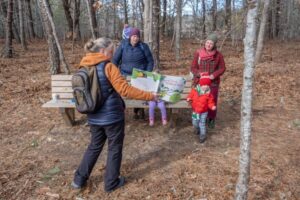 These awesome little critter companions kept us company as I read the fabulous story Good Trick, Walking Stick! by Sheri Mabry Bestor. This wonderful book inspires adventure and research into the fascinating world of entomology through its study of insects and nature with dynamic prose, fun-filled facts, and interesting artwork. Bestor’s nonfiction book shows how this insect survives and thrives throughout its life cycle. Readers learn the survival tricks that the walking stick employs to blend in, change color, lose and regrow limbs, and more!
These awesome little critter companions kept us company as I read the fabulous story Good Trick, Walking Stick! by Sheri Mabry Bestor. This wonderful book inspires adventure and research into the fascinating world of entomology through its study of insects and nature with dynamic prose, fun-filled facts, and interesting artwork. Bestor’s nonfiction book shows how this insect survives and thrives throughout its life cycle. Readers learn the survival tricks that the walking stick employs to blend in, change color, lose and regrow limbs, and more!
 On the path of discovery once more, we took our walking sticks for… a walk! Pausing along the trail, we set them down on tree branches to admire their brilliant camouflage! Taking in scenic views, we spotted buffleheads bobbing in Muddy Creek and the tall phragmites/common reeds growing along the water’s edge. A huge tree that had been blown over by strong winds was a perfect prop for imaginations as it transformed into a giant walking stick. Some of the Explores climbed onto its thorax and abdomen for an imaginary ride!
On the path of discovery once more, we took our walking sticks for… a walk! Pausing along the trail, we set them down on tree branches to admire their brilliant camouflage! Taking in scenic views, we spotted buffleheads bobbing in Muddy Creek and the tall phragmites/common reeds growing along the water’s edge. A huge tree that had been blown over by strong winds was a perfect prop for imaginations as it transformed into a giant walking stick. Some of the Explores climbed onto its thorax and abdomen for an imaginary ride!
An aura of joy blanketed the Muddy Creek Headwaters from the laughter, song, and curiosity of children and their caregivers. Such wonderful moments create the best memories as we explore Harwich’s Preserves.
Thank you for sharing this wonder-filled morning with me. I am already looking forward to our next adventure.
Happy Exploring.
Smiles,
Ms. Andrea

